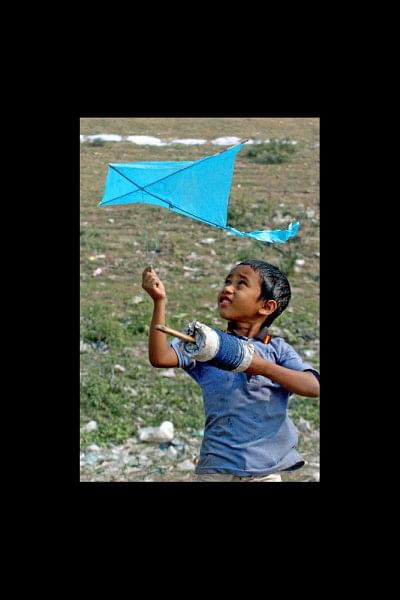And what of the dignity of the child?

For sceptics, observance of certain 'days' is seen as little more than a grand PR initiative to promote certain organisations working in the particular field or for governments to pay lip service to UN mandates. But going beyond the cynicism it is worthwhile to delve into the messages that these days try to convey. It is also an appropriate time to take stock of how far we as part of the fraternity of 'civilised nations' have been able to live up to the expectations these days wish to emphasise.
November 20 was chosen as Universal Children's Day to mark the anniversary when the UN General Assembly adopted both the declaration and convention on children's rights – in 1959 and 1989 respectively. The Universal Children's Day was to promote fraternity and understanding between children all over the world and also to promote their welfare.
The most significant message of the Convention on the Rights of the Child (CRC) is the obligation of every nation to uphold the dignity of the child. This encompasses pretty much everything that would be associated to child rights – the right to live, be given proper nutrition, shelter, a decent standard of living, education, health and so on. But it also recognises the importance of shunning any attempts to humiliate a child, to disrespect the child as a human being, to treat the child as a possession.
Bangladesh has done impressively well in major areas such as immunisation against major diseases, reducing infant mortality, and increasing primary education enrolment, that too with more girls in school than ever before and free primary education. But we have not made much progress when it comes to upholding the dignity of the child.
The starkest examples of this are instances of barbaric torture inflicted on children, often leading to grievous injury or death. The widely publicised brutal murders of Rajon who was tied up and ruthlessly beaten to death and Rakib whose former employer inserted a pump nozzle through the child's rectum to fill his abdomen with air until he died are enough to make us realise how far behind we are in terms of meeting the expectations of the Convention.
Article 19 highlights the child's right to be protected from all kinds of violence – from being mistreated physically or mentally. It stipulates that governments must ensure that all children be protected from abuse, neglect by parents or guardians, that any form of discipline involving violence is unacceptable. Put this against the news of seven-year-old Md Siam Hossain who was confined to a room with his feet tied because he kept running away from the madrasa to be with his parents. Other news stories have reported madrasa students being tied up, caned mercilessly, hung upside down from a ceiling and starved in order to discipline them. There have been reports of teachers and headmasters of regular schools inflicting cruel punishments on children. These horrible incidents are the tip of the iceberg when it comes to the actual number of children being subjected to degrading, physically injurious, torture within the schools, madrasas, orphanages and homes. And all this is happening despite a law that prohibits corporal punishment and Article 37 (of CRC) that prohibits anyone from punishing children in 'a cruel and harmful way'.
Now let's come to the issue of child labour, which basically violates quite a number of the Articles in the Convention. The right of all children, irrespective of race, religion, family background, nationality, etc. to free primary education, to a standard of living that is good enough to meet their physical and mental needs, the right to relax and play, to be a part of artistic activities, to be protected from hazardous work that harms their health and education – these are only a few of the rights that are blatantly violated with respect to child labour. Now think of the 1.3 million children working in hazardous jobs and 420,000 child domestic workers who are deprived of education, time for play, proper nutrition, adequate rest and health care. Many of these children are routinely punished and treated harshly with contempt and disrespect from the adults who employ them and their family members.
If it is the dignity of the child we are talking about nothing is more in contradiction to such a concept than child marriage – around 66 percent of girls are married off before they reach adulthood with one third of them being less than 15. By law, child marriage is prohibited as is the demand for dowry. Child marriage grossly contradicts the Convention for it legitimises sexual abuse, deprives the child of an education and adversely affects her health. Attempts to lower the legal age of marriage from 18 to 16 (for girls) indicate the complete disregard for the dignity of the child.
The Child Bill 2013 is supposed to be in harmony with the CRC and recognises that an individual below 18 is a child. Why then do we still have child marriages? Why then do we have little children working in homes, in biri factories, in garbage dumps and tanneries? Why then do we have little girls and boys being tortured to death by sadistic employers?
Thus while we may celebrate Universal Children's Day to honour those individuals who are our most precious treasures and who will shape the future of our nation, as the grownups, whether we are parents, policymakers or leaders -- who are responsible for protecting them, providing them with a minimally decent life and respecting them as human beings -- how well have we been doing our job? That probably should be the overriding theme of this day.
The writer is Deputy Editor, Editorial & Opinion, The Daily Star.

 For all latest news, follow The Daily Star's Google News channel.
For all latest news, follow The Daily Star's Google News channel. 








Comments